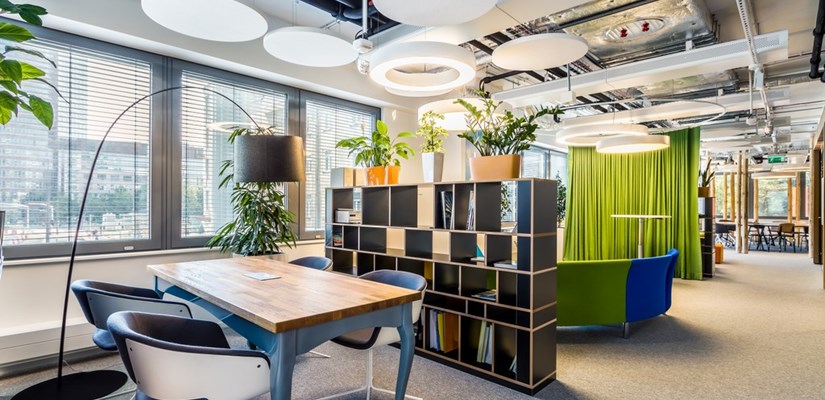A good architect will design a sidewalk where a path has already been trampled down. Designers of office space decided to go along and arrange office space based on employees' everyday activities. The motto is: instead of creating needs, answer them.

There are numerous ways that employees can work in offices designed in accordance with the latest trends. Either single-handedly or in groups, isolated from the outside world or with views of the city, sitting on chairs or cushions. Employees can even work in kitchens, sitting in an armchair with their feet up. The Activity Based Workplace concept champions open office space that is devoid of office desks and divided into different activity zones. This idea was maximally put into effect in the office of Skanska, the Swedish developer-construction company, in Atrium 1 building in Warsaw.
In an atmosphere of office freedom
Everyday dozens of Skanska employees in Warsaw start their day by sitting down together for breakfast in a modernly furnished, spacious kitchen. Afterwards, they can go about their business in a randomly chosen place that can differ from day to day. However, Skanska's office freedom had to have a strategy that was carefully prepared beforehand.
“For us, such an arrangement was a small revolution. Before we designed the area research was conducted by Workplace Solutions, which observed our daily activities over several weeks. They noted down the paths we walked, where we preferred to work as well as how much we spent on an individual task or meetings. The new office was to guarantee maximum comfort and fit in with the specificity of our work. Nevertheless, we had to drop the habit of sitting at our own desks, which if truth be told, rarely happened,” comments Katarzyna Zawodna, President at Skanska Property Poland.
The research drew several important conclusions. For example, all of the company's employees are never present in the office at the same time. Limiting the number of office desks and giving them an “available for anyone” status was a natural solution. Today, there are 80 employees who work this way in Warsaw while in Skanska's Stockholm office over 1,000 workers follow this innovative arrangement.
Silence, storm and relax
An inventively arranged office provides space for different kinds of activities. Those who need concentration on a daily basis have several options to choose from. One of them is an area for working in silence where there are 50 desks, the highest number in the office, as well as places for working at adjustable desks in a seated or standing position. For conversations with business partners, there are “phone booths” offering 3,5 sqm of space where one can comfortably sit with a laptop and have a longer chat. There are 8 conference rooms of various sizes designed for organizing teleconferences or offical meetings.
“Both silent and formal parts smoothly transfer into different areas. This arrangement also proves useful for informal meetings which are included in the creative zone. Here, employees can conduct project or 'brainstorming' meetings. When we need a break we can use the relax zone, where one can play table football, play on a games console or use the fitness room. On Fridays, we have office pilates sessions. This flexible office layout allows us also to be better integrated,” asserts Katarzyna Zawodna.
The importance of integrating employees is underlined in the latest "Health, Wellbeing & Productivity in Offices” report by the World Green Building Council. Research conducted in one of Bank of America’s call centers shows that by providing employees with common areas and opportunities to create informal social networks, the company was able to reduce the level of stress and cut employee turnover from 40% to 12%. This resulted in an estimated saving of $15 million in the bank's call center costs.
“Contrary to what one might expect, the development of new technologies, which have given employees the opportunity of teleworking, has not resulted in workers wanting to work from home. In fact, they want to meet and work together in an office area that is properly designed for their needs,” comments Katarzyna Zawodna.
The advantages
The advantages of such office arrangements were proved by managers of Planotronics company, a global producer of electronic equipment[1]. By reducing the number of conference rooms from 18 to 5, creating places designed for concentration, individual tasks, teamwork as well as informal meetings, staff absenteeism was reduced from 12.7 to 3.5% while workspace satisfaction increased from 25 to 85%.
“It is still too early to tell how big an impact these changes are having on our efficiency. Usually, they are conducted around 4-6 months after relocation. Nevertheless, staff satisfaction is noticeable and our clients are impressed with the office. In fact, it was our aim to express our company’s philosophy that focuses on people and their needs through space arrangement. We could limit the space, but we would rather give it to our staff. We advise our clients to do this as well. They will gain the loyalty and gratitude of their employees and in return reap the benefits”, comments Katarzyna Zawodna.
Will such solutions find their way onto the market?
“Companies follow trends and are interested in applying some of the solutions on offer. Each of them should be designed in accordance with how a particular organization or department operates. Companies want to respond to the changing work models as well as the needs of new generations and create space that integrates staff. We should bear in mind that the Z-generation will soon appear on the market. For some companies, it wil mean having 5 generations working under the same roof,” adds Katarzyna Zawodna.
You can take a virtual stroll around Skanska’s office at: http://goo.gl/maps/3orX4
[1] Report “Health, Wellbeing and Productivity”, World Green Building Council, 2014